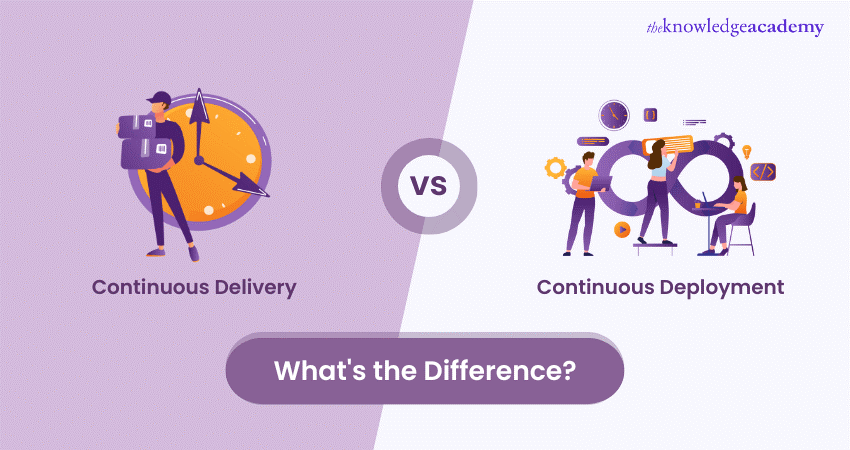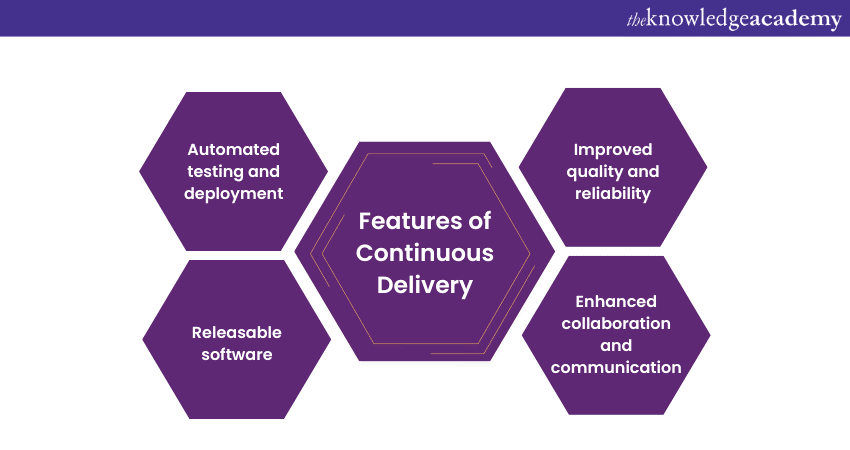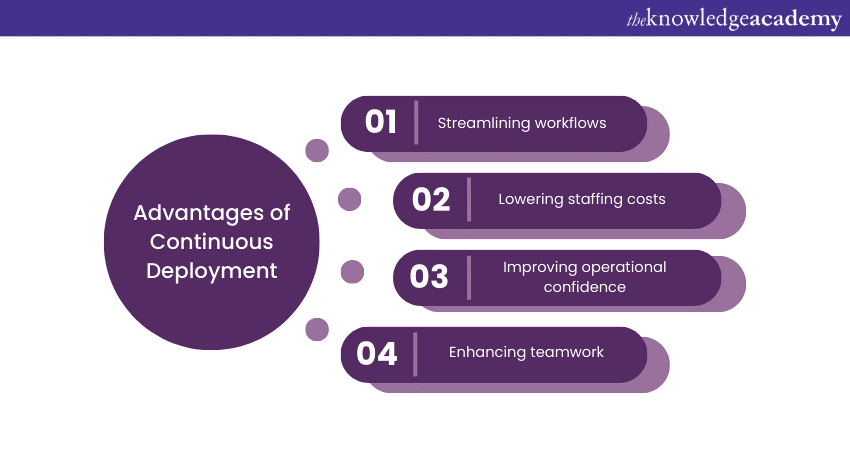We may not have the course you’re looking for. If you enquire or give us a call on +44 1344 203 999 and speak to our training experts, we may still be able to help with your training requirements.
Training Outcomes Within Your Budget!
We ensure quality, budget-alignment, and timely delivery by our expert instructors.

In the world of making software, there are two essential things to know: Continuous Delivery vs Continuous Deployment. These practices have revolutionised the way we develop, test, and deploy software, leading to faster development cycles, increased efficiency, and improved software quality. However, they aren't one and the same; they have distinct purposes and implications for your development pipeline.
But what's the difference between Continuous Delivery vs Continuous Deployment? That's what we're going to explore in this blog. We will explore the concepts of Continuous Delivery and Continuous Deployment, two practices that are often used in modern software development and DevOps. We will also compare and contrast them to understand their benefits and challenges.
Table of Contents
1) What is Continuous Delivery?
a) Advantages of Continuous Delivery
b) Features of Continuous Delivery
2) What is Continuous Deployment?
a) Advantages of Continuous Deployment
b) Features of Continuous Deployment
3) Continuous Delivery vs Continuous Deployment
4) Conclusion
What is Continuous Delivery?
Continuous Delivery is a way of making software that allows you to release it to users at any time. It means that you automate the steps of building, testing, and deploying your software so that you can always have a version that is ready to use. Continuous Delivery helps you to deliver software faster, with fewer errors and more feedback from users. It also makes it easier to experiment with new features and fix bugs quickly. Continuous Delivery is part of a larger approach called DevOps, which aims to improve the collaboration and communication between developers and operations teams.
Features of Continuous Delivery
Some of the features of Continuous Delivery are:

a) Automated testing and deployment: You use tools and scripts to build, test, and deploy your software changes to various environments. This reduces the manual errors, delays, and costs associated with these tasks.
b) Releasable software: You ensure that your software is always in a state that can be released to the users at any time. This enables faster feedback, shorter delivery cycles, and more frequent updates.
c) Improved quality and reliability: You improve the quality and reliability of your software by enabling frequent testing and feedback. You also detect and fix issues early in the development process before they reach the production environment.
d) Enhanced collaboration and communication: You enhance the collaboration and communication between the developers, testers, and operations teams by aligning them around a common goal of delivering software. You also foster a culture of automation, collaboration, and continuous learning.
Advantages of Continuous Delivery
Some of the advantages of Continuous Delivery are:
a) Streamlining workflows: You simplify and standardise your workflows by automating them. You also eliminate waste and inefficiencies by reducing handoffs and dependencies.
b) Lowering staffing costs: You reduce the need for specialised roles and skills by empowering your teams to perform multiple tasks. You also optimise the use of your resources by allocating them based on demand.
c) Improving operational confidence: You increase your confidence in your software by ensuring that it works as expected in production. You also reduce the risk and impact of failures by enabling fast recovery and rollback mechanisms.
d) Enhancing teamwork: You improve the teamwork and morale of your teams by giving them more autonomy and responsibility. You also encourage innovation and creativity by allowing them to experiment and learn from their mistakes.
What is Continuous Deployment?
Continuous Deployment is a way of making software that allows you to release it to users automatically. It means that you do not need any human approval to deploy your software changes to production as long as they pass the automated tests. Continuous Deployment helps you deliver software faster and more frequently, with less risk and more feedback from users. It also makes it easier to experiment with new features and learn from your mistakes.
Features of Continuous Deployment
Some of the features of Continuous Deployment are:
a) Automated testing and deployment: You use tools and scripts to build, test, and deploy your software changes to production. This reduces the manual errors, delays, and costs associated with these tasks.
b) Releasable software: You ensure that your software is always in a state that can be released to the users at any time. This enables faster feedback, shorter delivery cycles, and more frequent updates.
c) Rollback and release control: You have the ability to revert to a previous version of the software in case of any issues or errors. You also have the option to use feature flags, canary releases, or blue-green deployments to control how your software changes are released to different users or environments.
d) Performance and security testing: You ensure that your software meets the required standards and complies with the regulations by performing performance and security testing before and after deployment.
Advantages of Continuous Deployment
Some of the advantages of Continuous Deployment are:

a) Streamlining workflows: You simplify and standardise your workflows by automating them. You also eliminate waste and inefficiencies by reducing handoffs and dependencies.
b) Lowering staffing costs: You reduce the need for specialised roles and skills by empowering your teams to perform multiple tasks. You also optimise the use of your resources by allocating them based on demand.
c) Improving operational confidence: You increase your confidence in your software by ensuring that it works as expected in production. You also reduce the risk and impact of failures by enabling fast recovery and rollback mechanisms.
d) Enhancing teamwork: You improve the teamwork and morale of your teams by giving them more autonomy and responsibility. You also encourage innovation and creativity by allowing them to experiment and learn from their mistakes.
Unlock the power of secure DevOps with our Certified DevOps Security Professional (CDSOP) Course and safeguard your digital transformations today!
Continuous Delivery vs Continuous Deployment
Continuous Delivery and Continuous Deployment are both extensions of continuous integration, which is the practice of merging code changes frequently and running automated tests. However, they differ in the degree of automation and frequency of deployment.
Continuous Delivery requires human intervention to deploy the software to production, while Continuous Deployment does not. Continuous Delivery allows more control and flexibility over when and how to release the software, while Continuous Deployment enables faster feedback and learning from the users.
Both practices have their pros and cons, depending on the context and goals of the software project. Some factors that may influence the choice between them are:
a) The type and size of the software project. For example, a large-scale enterprise application may require more testing and validation before being released to production, while a small-scale web application may benefit from more frequent updates and experiments.
b) The maturity and stability of the software project. For example, a new or experimental project may need more iterations and feedback to validate its assumptions, while an established or critical project may need more caution and reliability to avoid any disruptions or failures.
c) The culture and mindset of the software team. For example, a team that embraces change and innovation may prefer Continuous Deployment, while a team that values stability and predictability may prefer Continuous Delivery.
Unlock the power of DevOps with our comprehensive DevOps Courses – accelerate your career today!
|
Factor |
Continuous Delivery |
Continuous Deployment |
|
Definition |
A software development practice where code changes are automatically prepared for a release to production. |
An extension of continuous delivery where every change that passes the automated tests is deployed to production automatically. |
|
Automation level |
High - Automates the release process up to production. Manual intervention required to deploy to production. |
Very high - Fully automates the release process, including deployment to production. No manual intervention. |
|
Deployment frequency |
Regular and scheduled but requires manual approval for each deployment. |
Continuously and automatically, as soon as updates are ready, and tests are passed. |
|
Focus |
Ensures that the software can be reliably released at any time. |
Focuses on reducing the time between writing new code and this code being used by live users. |
|
Risk management |
Allows for more control and risk management, as deployments can be scheduled and reviewed. |
Potentially higher risk as changes are deployed automatically but mitigated by rigorous automated testing. |
|
Feedback loop |
Faster than traditional methods, but slightly slower than continuous deployment due to manual steps. |
Very fast, as changes are deployed immediately, allowing for immediate user feedback. |
|
Suitability |
Suitable for businesses that require a final review or compliance checks before deployment. |
Ideal for organisations with a strong automation infrastructure and a need for rapid iterations. |
|
Examples of use cases |
Enterprise applications, regulated industries, applications requiring extensive QA. |
High-velocity tech companies, web applications, startups with rapid iteration cycles. |
|
Tooling |
CI servers, automated testing frameworks, release automation tools. |
Same as Continuous Delivery, with additional emphasis on robust testing and monitoring tools. |
|
Human involvement |
Yes - human approval is often required for final deployment. |
Minimal - most processes, including deployment, are automated. |
Conclusion
We've explored Continuous Delivery vs Continuous Deployment, two methods of automating software changes. Continuous Delivery maintains software in a releasable state, while Continuous Deployment releases every change to production. Both enhance software development's quality and speed. Choosing between them hinges on factors like project type, size, culture, and stability, involving a trade-off between control and flexibility and feedback and learning.
Unlock the power of DevOps excellence with the Certified DevOps Professional (CDOP) Course and revolutionize your career today!
Frequently Asked Questions
Upcoming Programming & DevOps Resources Batches & Dates
Date
 Certified DevOps Professional (CDOP)
Certified DevOps Professional (CDOP)
Thu 30th Jan 2025
Thu 27th Mar 2025
Thu 29th May 2025
Thu 24th Jul 2025
Thu 25th Sep 2025
Thu 27th Nov 2025







 Top Rated Course
Top Rated Course



 If you wish to make any changes to your course, please
If you wish to make any changes to your course, please


